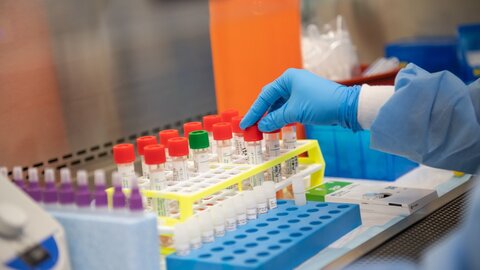Research tools
eTraining for stool-based qPCR diagnostics for soil-transmitted helminths

This collection of videos covers a series of training resources including: stool-based DNA extractions, pre-PCR and qPCR preparation, primer and probe resuspension for qPCR assays, qPCR software set-up (with a demo on a StepOne Plus instrument), and demo of a Python script for combining qPCR data; all demonstrated with explanatory instructions and detailed voice over by Marina Papaiakovou.
Short description of videos:
CLIP1: This video demonstrates the extraction of DNA from stool samples, using the FAST SPIN kit for soil from MP Biomedicals. The video contains tips and explanations at each step of the process, but these instructions are not a substitute for following standard operating procedures.
CLIP2: This video demonstrates: i) resuspension of primers/probes used in qPCR testing, ii) preparation of the master mix for qPCR reactions and loading a 96-well plate, and, iii) aliquoting of the reagent mix (a mix containing enzyme, salts etc). The video contains tips and explanations at each step of the process, but these instructions are not a substitute for following standard operating procedures.
CLIP3: This video demonstrates: i) serial dilutions of DNA standards (or positive controls), ii) loading of DNA samples in the qPCR 96-well plate, and iii) sealing and spinning of the qPCR plate. The 96-well template introduced in this video covers the screening of 39 DNA samples in duplicate, DNA standards in triplicate and non-template controls, also in triplicate. Each plate contains the screening of a single target (e.g., single STH species or extraction control). The video contains tips and explanations at each step of the process, but these instructions are not a substitute for following standard operating procedures.
CLIP4: This video shows: i) the qPCR software set-up for the detection of soil-transmitted helminths, and ii) the review of previous qPCR runs with some troubleshooting. We have used the StepOne Plus instrument from Thermofisher for the demonstration of “Standard curve/Absolute quantification”, advanced set up. Visit your instrument’s manual for more details and guidance with the set-up for your work.
CLIP5: A tutorial on running a script written in Python (provided by Panos Bozelos), for compiling the individually exported qPCR file outputs, as ‘.xlsx’ files (demonstrated in CLIP4) into a single master file for downstream analysis in R or equivalent.
Time stamps:
CLIP1 (total duration 42:21)
- Equipment needed (suggested): 2:28
- Phosphate buffer and lysis buffer addition: 3:38
- Stool sampling: 5:26
- Homogeniser settings: 10:05
- Protein precipitation step (PPS): 11:53, 16:00
- Adding extraction control & binding matrix step: 13:24 (loading binding matrix), 20:34 (adding control to PPS precipitated tubes), 21:36 (loading samples to binding matrix) – watch the entire video for clarity in the sequence of events.
- Loading liquid matrix to spin filters: 25:00 (prep of spin filters), 25:56 (removing excess liquid and loading matrix into filters)
- Washing steps with ethanol buffer: 31:30
- Final elution step: 37:19
- References: 42:00
- Acknowledgements: 42:30
CLIP2:
- Equipment and reagents needed (suggested): 0:36, 0:54
- Primer/probe resuspension: 1:14
- Pre-PCR mix: 4:26
- Reagent mix aliquoting: 8:42
- References: 8:49
- Acknowledgements: 09:00
CLIP3:
- Equipment & reagents needed: 0:25
- DNA standards preparation: 0:50, 02:38 (for tRNA preparation), 2:52 (for dilutions)
- Loading DNA samples: 06:09, 7:47 (96-well plate template)
- Sealing & spinning the plate: 09:52
- References: 14:00
- Acknowledgements: 14:13